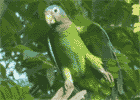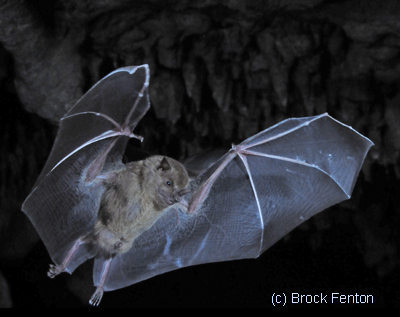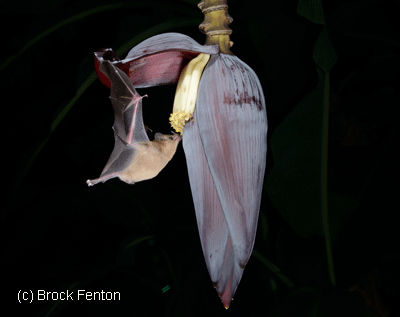 |
FREQUENTLY ASKED QUESTIONS: |
 |
Click on a question to see the answer
 Jamaican Fruit Bat (Artibeus jamaicensis) |
FAQ's: Jamaican Bats (aka Ratbats) |
 Pallas' Long-tongued Bat (Glossophaga soricina) |
Q1: Help! A ratbat likes to carry fruit into my house at night, it hangs from a window frame / ceiling and is making a terrible mess. I don't want to harm it, but how can I get it to stop coming into my house?
A1: This is our most frequently-asked FAQ about Jamaican bats.
To solve the problem, it helps to understand why the bat is coming into your house in the first place. And don't panic, it's easy to train wild bats to stay out of your house.
The bat (most often it is a Jamaican Fruit Bat) has learned that the window frame or ceiling is a safe and comfortable place to eat its fruit or to rest during the night. This is particularly the case when your fruit trees (esp. Almond Trees [Terminalia catappa] and Naseberry [Manilkara zapota]) are filled with lots of mature fruits.
Q2: What are the chances that Jamaican bats carry Ebola?
A2: The short answer: although there has been no surveillance testing of wildlife in Jamaica, it is highly unlikely that our bats harbour a virus in the genus Ebolavirus (Family Filoviridae). At the time of posting this FAQ (27th October 2014),
no virus species in the Family Filoviridae has been detected in free-ranging wildlife (including bats) in the New World.
But because of the extreme seriousness of Ebola, please visit our "Facts about Jamaican Bats & Ebolavirus"
Q3: Help! Ratbats are living in my ceiling! They're making a terrible mess, the smell is bad, and they make a whole heap of noise during the day. How can I get them to move out?
A3: We're going to send you to the website of the National Trust for the Cayman Islands: www.nationaltrust.org.ky. Their "What to Do About Bats in the Roof" webpage covers all details about why some species of bats set-up residence in buildings and their PowerPoint presentation shows how an excluder device can be fitted so bats can leave, but not re-enter your roof. They also have an excellent programme of erecting "bat houses" -- alternatives to your roof -- with the support of Caribbean Utilities Co., Ltd. (CUC) [ Follow the links in the "What to Do..." article or use the "Bats" menu button at http://www.http://www.caymanwildlife.org/ ].
NOTE: If you do need to clean out a large accummulation of bat guano from your ceiling, wear a respirator that can guard against particles as small as two microns. This will protect you if the fungal spore Histoplasma capsulatum is present in the bat droppings. This fungus, which grows in soils enriched by animals droppings, including those from bats and birds (e.g., poultry farms), causes the respiratory disease Histoplasmosis.